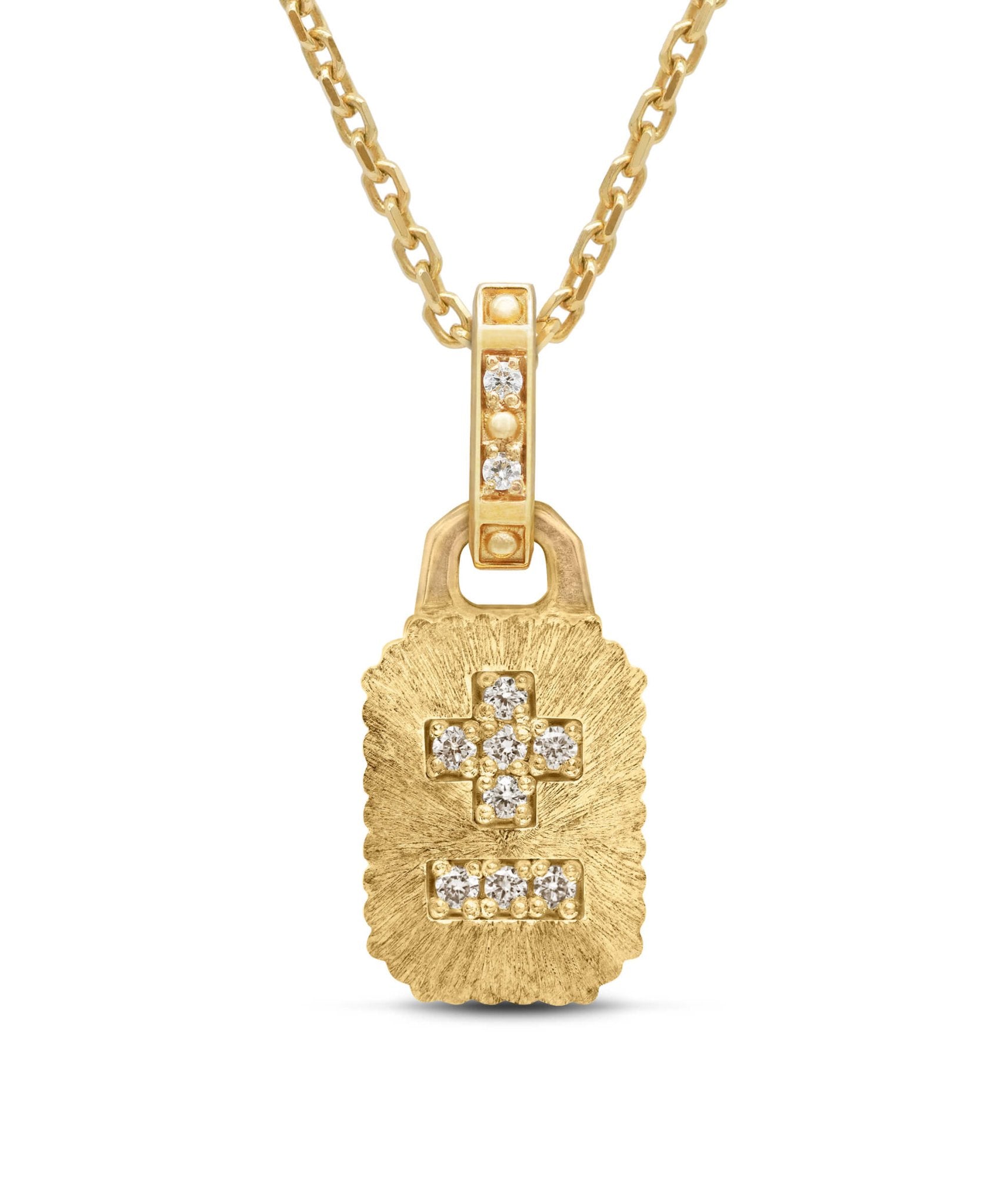Symbols have always played a vital role in human culture, transcending time and geography to convey profound meanings and universal truths. Among these, the honeycomb stands out as a remarkable emblem of nature's ingenuity and beauty. Its perfect hexagonal structures, crafted meticulously by bees, have inspired awe and admiration for centuries. The honeycomb's significance extends beyond its physical form, embodying ideals such as unity, diligence, harmony, and abundance. From ancient Egypt to modern Freemasonry, and from Greek mythology to Islamic art, the honeycomb has woven its way into various cultural narratives, each imbuing it with unique interpretations and reverence.
Amuletha™ Book of Symbols
Honeycomb Symbol
*Honeycomb by Jo-Dojoong
Most of Jo-Dojoong's works are abstract, but "Honeycomb" is comparatively more realistic. However, the distortion near the center and bottom indicates it is not entirely realistic. This piece aims to convey the texture of the soil more accurately than imaginative or expressive techniques.
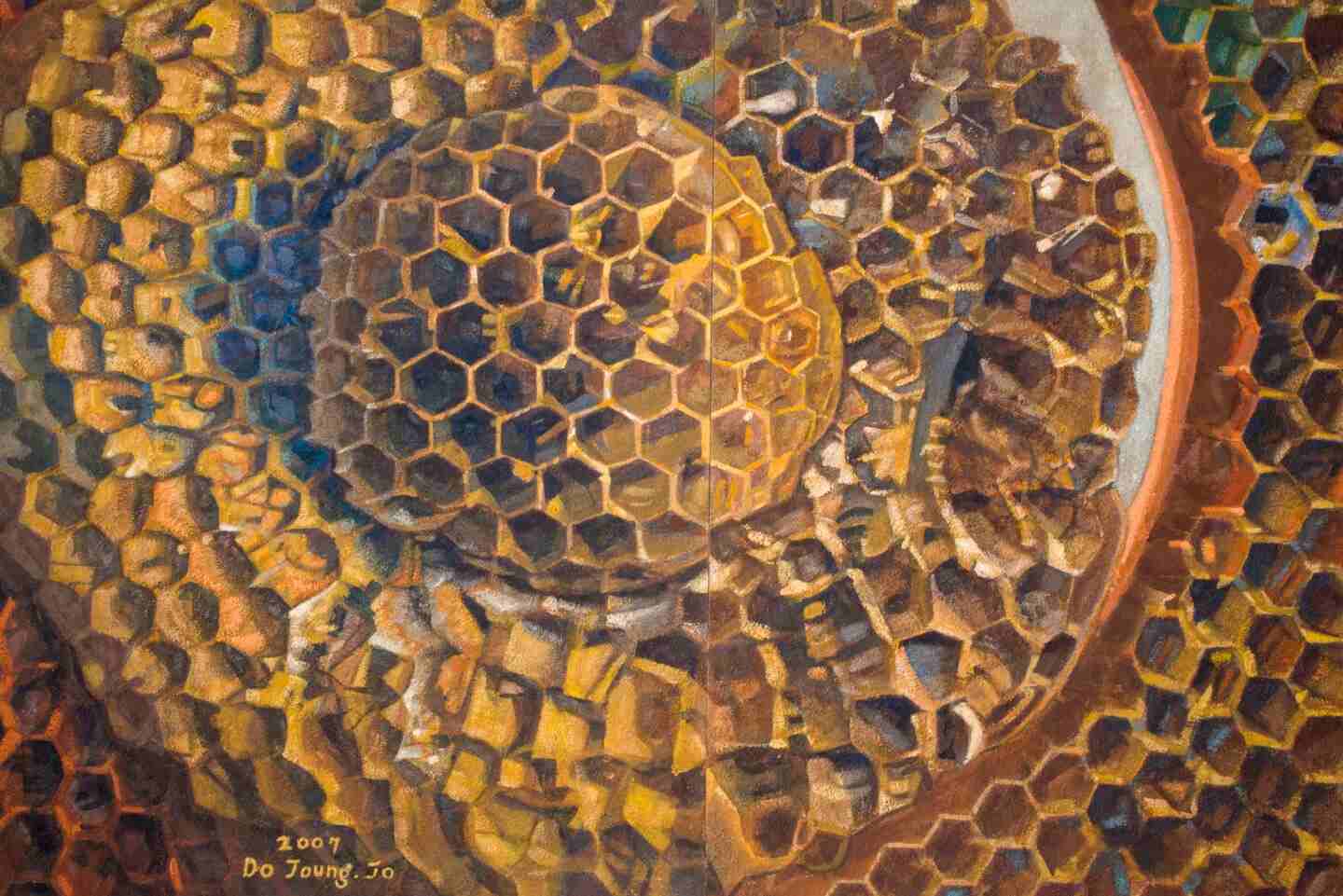
*Honeycomb by Jo-Dojoong
Most of Jo-Dojoong's works are abstract, but "Honeycomb" is comparatively more realistic. However, the distortion near the center and bottom indicates it is not entirely realistic. This piece aims to convey the texture of the soil more accurately than imaginative or expressive techniques.
HONEYCOMB SYMBOL ORIGIN
The honeycomb symbol has a rich history rooted in ancient times, revered for its intricate structure and profound meaning. The origin of the honeycomb symbol can be traced back to ancient Egypt, around 3000 BCE, where it was associated with the pharaohs and the divine. The Egyptians admired bees for their industrious nature and viewed the honeycomb as a representation of both hard work and eternal life. Hieroglyphs often depicted the honeycomb, emphasizing its importance in their culture and religion.
In the classical Greek and Roman eras, the honeycomb continued to symbolize efficiency, cooperation, and the fruits of labor. Philosophers like Aristotle documented the meticulous nature of bees and their creation of hexagonal structures, marveling at the geometric precision and natural beauty of the honeycomb. This admiration permeated into various aspects of life, including art and literature, where the honeycomb was used to illustrate concepts of harmony and unity.
The Middle Ages saw the honeycomb symbol take on a more spiritual meaning, particularly within Christian contexts. The hexagonal cells were often seen as symbols of the divine order and the universe's perfect design. Monasteries and cathedrals incorporated honeycomb patterns into their architecture, symbolizing the harmony between the earthly and the divine. The honeycomb's significance was also evident in alchemical texts, where it represented the idea of transmutation and the pursuit of spiritual enlightenment.
What does honeycomb symbolize
The honeycomb symbol transcends cultures and time periods, rich with profound symbolism. Here are four most recognized interpretations of what the honeycomb conveys:
Unity
The honeycomb symbolizes unity and cooperation, reflecting how individual bees work together to create a complex, cohesive structure.
Diligence
Representing hard work and industriousness, the honeycomb is a testament to the tireless efforts of bees, symbolizing productivity and perseverance.
Harmony
The geometric precision and symmetrical beauty of the honeycomb signify harmony and balance, illustrating the natural order and interconnectedness of life.
Abundance
Often associated with the sweetness of honey, the honeycomb symbolizes abundance and the rewards of collective effort, signifying prosperity and fulfillment.
Cultural mention
The honeycomb is more than just a marvel of natural engineering, it is a symbol rich with cultural significance and profound meanings across various societies. Its hexagonal structure, created through the collective efforts of bees, has inspired humans for centuries, representing ideals such as unity, industry, and the intricate balance of nature. The honeycomb's association with sweetness and abundance further enriches its symbolic value, making it a powerful emblem in different cultural contexts.
The God beekeping
In Greek mythology, Aristaeus, the son of Apollo and the nymph Cyrene, is celebrated as the god of beekeeping. According to legend, Aristaeus was taught the secrets of beekeeping by the nymphs of Mount Nysa. He shared this valuable knowledge with humanity, teaching them how to cultivate bees and harvest honey. The honeycomb, as a result, became a symbol of his divine gift to mankind, embodying knowledge, fertility, and the sweetness of life. One poignant tale involves Aristaeus' bees dying as a consequence of his actions against Eurydice, the wife of Orpheus. In his grief, he sought the advice of the oracle Proteus, who instructed him to make sacrifices to appease the gods. From the carcasses of the sacrificed animals, new swarms of bees miraculously emerged, reaffirming the honeycomb as a symbol of rebirth and the interconnectedness of life. This myth underscores the honeycomb's role in Greek culture as a representation of nature's bounty, divine favor, and the intricate balance of the natural world.
*Aristaeus, created in 1565, designed by Frans Floris and printed by Cornelis Cort
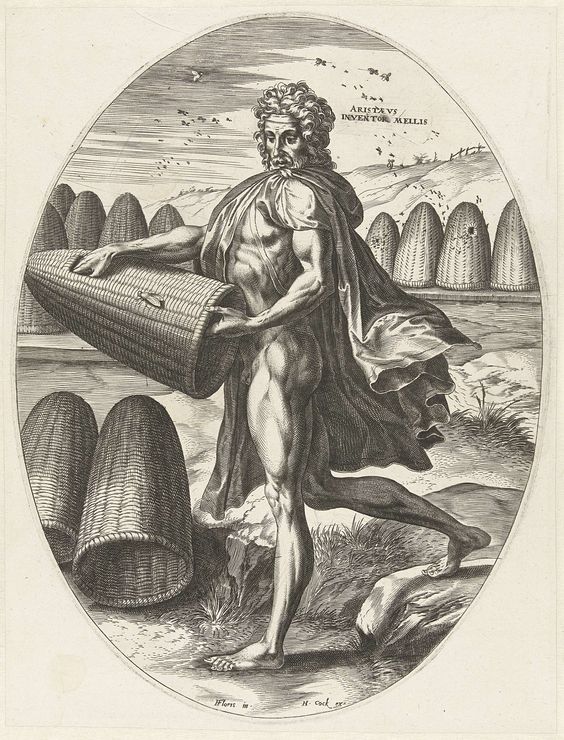
*Aristaeus, created in 1565, designed by Frans Floris and printed by Cornelis Cort
Honeycomb patterns in Islamic art
Islamic art and architecture are renowned for their intricate and breathtaking geometric designs, among which the honeycomb pattern, known as "muqarnas," holds a special place. Muqarnas are three-dimensional, honeycomb-like structures that adorn domes, arches, and ceilings in mosques, madrasas, and palaces. These stunning designs are not just decorative; they also reflect deep spiritual and philosophical meanings. The complex, interlocking shapes of the muqarnas symbolize the infinite nature of Allah and the intricate order of the universe. By creating a visual representation of heaven, these patterns remind worshippers of the divine presence and the harmony that underlies creation. The meticulous craftsmanship required to produce muqarnas is a testament to the skill and devotion of Islamic artisans, who saw their work as a form of worship. This enduring art form highlights the cultural and spiritual significance of the honeycomb structure in Islamic tradition, blending beauty with profound religious symbolism.
*Muqarnas - architectural details in the Imam Mosque in Isfahan, Iran.
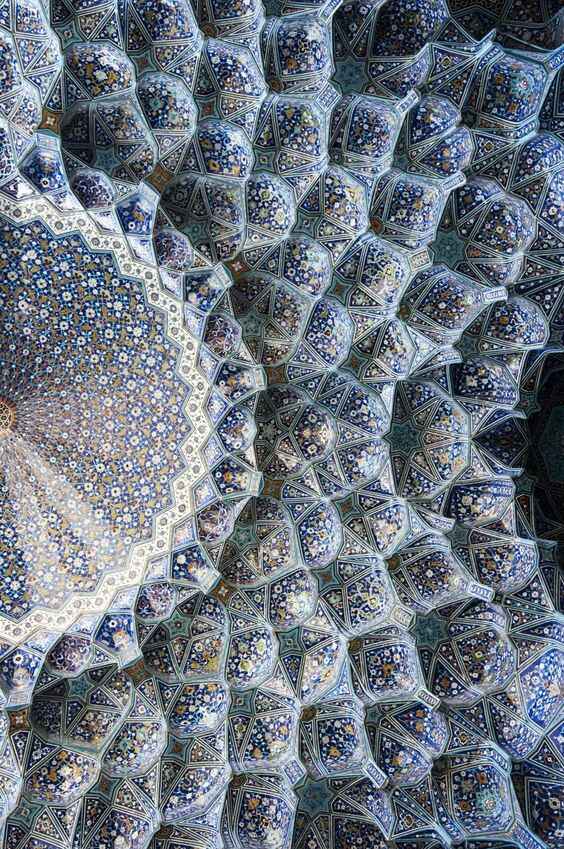
*Muqarnas - architectural details in the Imam Mosque in Isfahan, Iran.
Honeycomb in Freemasonry
In Freemasonry, the honeycomb symbolizes industry, cooperation, and the rewards of diligent work. The honeycomb, created through the collective efforts of bees, serves as a powerful metaphor for the Masonic values of unity and hard work. Freemasons view the honeycomb as an emblem of the industriousness that members are encouraged to emulate in their personal and professional lives. The hexagonal structure of the honeycomb, representing efficiency and precision, aligns with the Masonic emphasis on order and geometry. This geometric perfection also symbolizes the harmony and balance that Freemasons strive to achieve within their lodges and communities. Additionally, the honeycomb’s association with sweetness and abundance reflects the ideal that diligent efforts will lead to fruitful and rewarding outcomes, both for individuals and the community.The honeycomb, therefore, encapsulates the essence of cooperation, resilience, and the pursuit of collective well-being.
*Bee skep (detail) in Jeremy L Cross, ‘The true Masonic chart’ AS Barnes and Co, New York, 1855
The honeycomb is a very old Masonic symbol that is still used in many countries, but in England and Wales it was dropped after the Union of 1813. It can still be seen in some older pre-Union lodges.
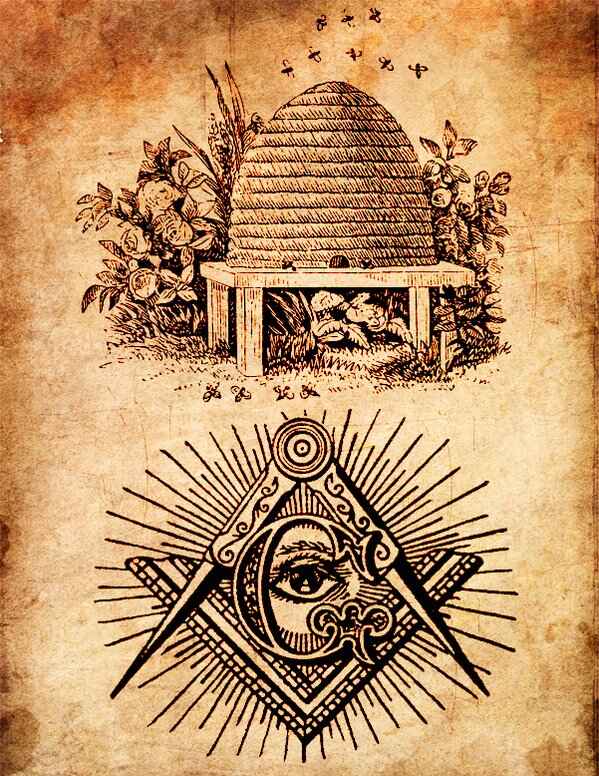
*Bee skep (detail) in Jeremy L Cross, ‘The true Masonic chart’ AS Barnes and Co, New York, 1855
The honeycomb is a very old Masonic symbol that is still used in many countries, but in England and Wales it was dropped after the Union of 1813. It can still be seen in some older pre-Union lodges.
Honeycomb symbol in the world of jewelry
The honeycomb symbol in jewelry often attracts individuals who value hard work, community, and the natural world. People who wear honeycomb-themed jewelry span various age groups, but it particularly appeals to those who appreciate the symbolism of unity and industriousness. The intention behind wearing this symbol is to embody the qualities of bees—diligence, cooperation, and the ability to create something beautiful through collective effort. Many wear it as a reminder of the importance of contributing to a greater good and maintaining harmony in their personal and professional lives. Additionally, the honeycomb pattern is often associated with natural beauty and sustainability, making it a favorite among environmentally conscious consumers.When given as a gift, honeycomb jewelry carries a profound message of admiration and respect for the recipient's hard work and dedication. It symbolizes a wish for abundance, harmony, and success in the recipient’s endeavors. An interesting gifting instance is during a graduation, where honeycomb jewelry can represent the culmination of hard work and the sweet rewards of success. Similarly, it makes a thoughtful gift for team members or colleagues, celebrating collective achievements and encouraging continued cooperation and mutual support.
What does a honeycomb symbolize in literature?
The honeycomb symbol holds a significant place in literature, often representing themes of community, hard work, and the intricate beauty of nature. Symbols in literature serve to convey deeper meanings and the honeycomb, with its geometric precision and collective creation, is frequently used to illustrate the interconnectedness of life and the rewards of collaboration. This symbol appears across various genres, from poetry to novels, emphasizing the value of diligence and unity. Notable mentions include works by authors who explore nature's wonders and human society’s structure.
"The Secret Life of Bees" by Sue Monk Kidd
In this novel, the honeycomb represents the communal and supportive relationships among the female characters, much like the cooperative nature of bees. The beekeeping elements in the story symbolize the intricate and sometimes painful processes of healing and self-discovery, reflecting the protagonist's journey towards understanding and forgiveness.
Black Madonna from The Secret Life of Bees by Sue Monk Kidd
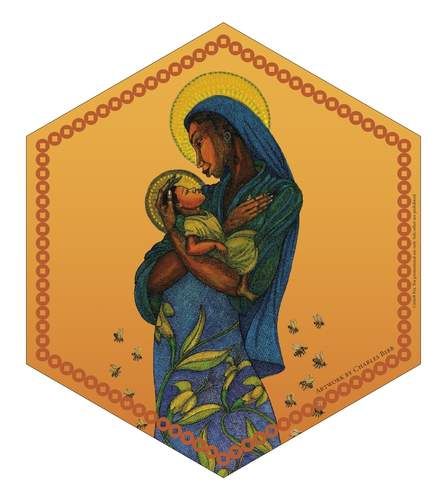
"The Lake Isle of Innisfree" by W.B. Yeats
I will arise and go now, for always night and day
I hear lake water lapping with low sounds by the shore;
While I stand on the roadway, or on the pavements grey,
I hear it in the deep heart's core.
This excerpt captures the tranquil yet industrious environment that the honeycomb symbolizes, emphasizing a retreat into nature and self-sufficiency.
"Beehive" by Jean Toomer
Within this black hive tonight
There swarm a million bees;
Bees passing in and out the moon,
Bees escaping out the moon,
Bees returning through the moon,
Silver bees intently buzzing,
Silver honey dripping from the swarm of bees.
Toomer's poem uses the beehive as a metaphor for the bustling, interconnected lives of people, highlighting themes of community and collective effort.
"The Beekeeper's Daughter" by Sylvia Plath
The bees are flying. They taste the spring.
Their wings are stained with honey.
My daughter is engaged in her own spring.
Her world is also buzzing
Plath's poem touches on themes of renewal and the cyclical nature of life, with the honeycomb symbolizing the order and productivity that comes from nature's rhythms.
Thoughts
Thoughts placed alongside a symbol resonate with its meaning, serving as a guide to expand your understanding of the symbol's significance in relation to your personal experiences. AMULETHA™ also embraces this approach, invites a deeper contemplation of how symbolic meanings can reflect and enrich your life’s narrative, enhancing your appreciation of both the symbol and its broader implications.
Celestial Synchronicity - In the sacred dance of creation, bees weave their intricate tapestry, each thread harmonizing in a cosmic symphony of unity.
Eternal Endeavor - In the timeless pursuit of purpose, bees labor with unwavering spirit, their golden labyrinth a testament to relentless diligence.
Sacred Geometry - Within the divine blueprint, the honeycomb emerges, a manifestation of perfect balance and celestial harmony, reflecting the universe's grand design.
Golden Bounty - Bathed in the glow of divine nectar, the honeycomb overflows with sweetness, symbolizing nature's generous abundance and the fruits of collective toil.
FREQUENTLY ASKED QUESTIONS
What is the function of a honeycomb?
The purpose of a honeycomb is to store honey and pollen, and to house bee larvae. Its hexagonal structure maximizes space and efficiency, allowing bees to use minimal wax to create a strong and durable storage system.
What is the theory of the honeycomb?
The honeycomb theory proposes that a hexagonal grid has the smallest total perimeter for dividing a plane into regions of equal area. Mathematician Thomas C. Hales proved this theory in 1999.
Does honeycomb possess healing properties?
Honeycomb offers various health benefits, including antioxidants, anti-inflammatory properties, and support for heart health. It also provides natural enzymes, helps with allergies, and promotes oral health by chewing the wax, which can aid in cleaning teeth.
What does honeycomb represent in the Bible?
In the Bible, honeycomb represents abundance, prosperity, and the sweetness of God's word. It is often used as a metaphor for spiritual nourishment and divine wisdom, highlighting the richness and fulfillment that come from following God's teachings.
















